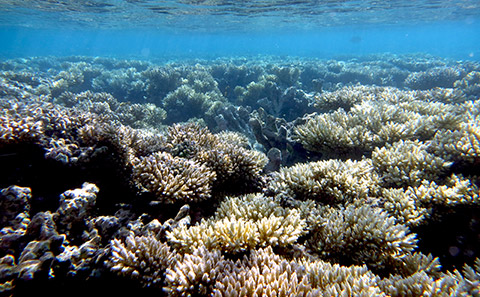
A new study, by an international team of scientists, has found the presence of seabirds on islands near to tropical reefs helps corals to 'bounce back' much quicker from bleaching events. Bleaching can cause mass die off of corals when seas are too hot.
The research, led by Lancaster University, with support from the University of Southampton, shows that this accelerated recovery is a result of faster coral growth near seabird colonies.
The key to how seabirds help tropical coral reefs to grow and recover more quickly is through their droppings. Seabirds feed on fish in the open ocean and then return to islands to roost. The droppings , called 'guano', derived from their fish diet, concentrate nitrogen and phosphorus-rich nutrients from a wider ocean region on the comparably small area of the bird islands. Some of these nutrients enter into the surrounding sea where they act as fertilisers for corals and other marine species.
The Southampton researchers, Dr Loreto Mardones Velozo, Dr Cecilia D'Angelo and Professor Jörg Wiedenmann helped to determine nitrogen-stable isotope values in corals – a reliable measure to trace nutrients derived from guano.
Professor Jörg Wiedenmann, Head of the University of Southampton's Coral Reef Laboratory, comments: "Our team has recently discovered that corals can access seabird nutrients by feeding on their own symbiont algae. It is exciting to see, in this latest research, how this new nutritional pathway not only helps corals to grow faster, but also to recover from bleaching events."
The study, published in Science Advances, focused on Acropora, an important type of coral that provides complex structures supporting fish populations and reef growth, as well as protection for coastal areas from waves and storms. Acropora around islands with seabirds were found to recover from bleaching events within approximately three years and eight months, around 10 months faster compared to reefs located close to islands, without seabird colonies, which took four years and six months to regenerate.

The scientists say these shorter recovery times could prove vital in aiding some reefs to bounce back in the face of a warming planet, where damaging bleaching events now occur much more frequently than in earlier decades.
"Our results clearly show that seabird-derived nutrients are directly driving faster coral growth rates and faster recovery rates in Acropora coral," said Dr Casey Benkwitt, research fellow in coral reef ecology at Lancaster University and lead author of the study.
"This faster recovery may be critical as the average time between successive bleaching events was 5.9 years in 2016 – a reduction from 27 years in the 1980s. Even small reductions in recovery times during this window may be key to maintaining coral cover over the short-term," she added.
The team's study focused on a remote archipelago in the Indian Ocean. They compared reefs next to islands with thriving populations of seabirds, such as red-footed boobies, sooty terns and lesser noddies, against reefs next to islands with few seabirds.
The reefs in the study area suffered extensive coral bleaching and mortality following marine heatwaves in 2015-16, providing an opportunity to observe and compare how coral on different reefs recovered. The researchers surveyed the sites from one year before the bleaching event to six years after bleaching, and modelled the Acropora recovery for the years between surveys.
The results showed that seabird-derived nutrients taken up by corals next to 'bird islands' boosted coral growth rates – with the rate doubling for each unit of seabird nutrient increase. In contrast, corals near islands infested with rats, causing there to be fewer birds, had similar nutrient values to corals that live at a distance from islands. The additional supply of nutrients to the corals by the seabirds had been virtually cut off by the rats.
The scientists also undertook a coral transplantation experiment to check the results weren't due to genetic differences in coral populations between different islands. They could confirm it was indeed the presence of seabirds that caused the faster growth. They say their findings add further weight to the growing body of evidence showing ecological damage across ecosystems, on land and sea, from invasive rats on tropical islands.
Professor Nick Graham of Lancaster University and Principal Investigator of the study said: "Combined, these results suggest that eradicating rats and restoring seabird populations could play an important role in re-establishing the natural flows of seabird nutrients to the nearshore marine environment, bolstering rapid coral reef recovery which will be critical as we expect to see more frequent climate disturbances."
The study, outlined in the paper 'Seabirds boost coral reef resilience', was supported by the Bertarelli Foundation as part of the Bertarelli Programme in Marine Science.






